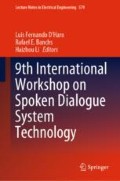Abstract
This paper proposes a method with which an interview dialogue system can learn user-friendly dialogue strategies. Conventional interview dialogue systems mainly focus on collecting the user’s information and simply repeat questions. We have previously proposed a method for improving user impressions by engaging in small talk during interviews that performs frame-based dialogue management and generates small-talk utterances after the user answers the system’s questions. However, the utterance selection strategy in the method was fixed, making it difficult to give users a good impression of the system. This paper proposes a method for learning strategies for selecting system utterances based on a corpus of dialogues between human users and a text-based interview dialogue system in which each system utterance was evaluated by human annotators. This paper also reports the results of a user study that compared the proposed method with fixed utterance selection strategies.
Access this chapter
Tax calculation will be finalised at checkout
Purchases are for personal use only
Notes
- 1.
DeVault et al. developed a virtual human interviewer for automatic assessment of distress indicators [1]. It can generate an utterance after the user answers the system question. This is a kind of small talk, although the objective the system is different from ours, which is to obtain structured information.
References
DeVault D, Artstein R, Benn G, Dey T, Fast E, Gainer A, Georgila K, Gratch J, Hartholt A, Lhommet M, Lucas GM, Marsella S, Morbini F, Nazarian A, Scherer S, Stratou G, Suri A, Traum DR, Wood R, Xu Y, Rizzo AA, Morency LP (2014) SimSensei Kiosk: a virtual human interviewer for healthcare decision support. In: International conference on autonomous agents and multi-agent systems, pp 1061–1068
Fan RE, Chang KW, Hsieh CJ, Wang XR, Lin CJ (2008) LIBLINEAR: a library for large linear classification. J Mach Learn Res 9:1871–1874
Higashinaka R, Imamura K, Meguro T, Miyazaki C, Kobayashi N, Sugiyama H, Hirano T, Makino T, Matsuo Y (2014) Towards an open-domain conversational system fully based on natural language processing. In: International conference on computational linguistics, pp 928–939
Johnston M, Ehlen P, Conrad FG, Schober MF, Antoun C, Fail S, Hupp A, Vickers L, Yan H, Zhang C (2013) Spoken dialog systems for automated survey interviewing. In: Annual meeting of the special interest group on discourse and dialogue, pp 329–333
Kobori T, Nakano M, Nakamura T (2016) Small talk improves user impressions of interview dialogue systems. In: Annual meeting of the special interest group on discourse and dialogue, pp 370–380
Kudo T, Yamamoto K, Matsumoto Y (2004) Applying conditional random fields to Japanese morphological analysis. In: Proceedings of the conference on empirical methods in natural language processing, pp 230–237
Lucas GM, Gratch J, King A, Morency LP (2014) It’s only a computer: virtual humans increase willingness to disclose. Comput Hum Behav 37:94–100
Okazaki N (2007) CRFsuite: a fast implementation of conditional random fields (CRFs). http://www.chokkan.org/software/crfsuite/
Otsuka T, Komatani K, Sato S, Nakano M (2013) Generating more specific questions for acquiring attributes of unknown concepts from users. In: Annual meeting of the special interest group on discourse and dialogue, pp 70–77
Stent A, Stenchikova S, Marge M (2006) Dialog systems for surveys: the rate-a-course system. In: IEEE spoken language technology workshop, pp 210–213
Wallace RS (2009) The anatomy of A.L.I.C.E. Parsing the Turing Test, pp 181–210
Wilks Y, Catizone R, Worgan S, Dingli A, Moore R, Field D, Cheng W (2011) A prototype for a conversational companion for reminiscing about images. Comput Speech Lang 25(2):140–157
Author information
Authors and Affiliations
Corresponding author
Editor information
Editors and Affiliations
Rights and permissions
Copyright information
© 2019 Springer Nature Singapore Pte Ltd.
About this paper
Cite this paper
Nakamura, T., Kobori, T., Nakano, M. (2019). Learning Dialogue Strategies for Interview Dialogue Systems that Can Engage in Small Talk. In: D'Haro, L., Banchs, R., Li, H. (eds) 9th International Workshop on Spoken Dialogue System Technology. Lecture Notes in Electrical Engineering, vol 579. Springer, Singapore. https://doi.org/10.1007/978-981-13-9443-0_27
Download citation
DOI: https://doi.org/10.1007/978-981-13-9443-0_27
Published:
Publisher Name: Springer, Singapore
Print ISBN: 978-981-13-9442-3
Online ISBN: 978-981-13-9443-0
eBook Packages: Literature, Cultural and Media StudiesLiterature, Cultural and Media Studies (R0)

